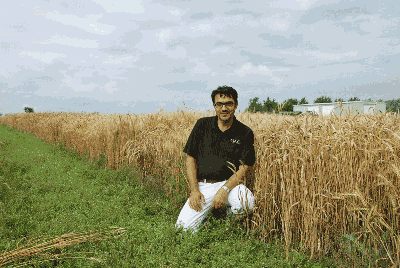The future of Ontario winter wheat
PROFESSORSHIP IN WHEAT BREEDING
DR. ALI NAVABI has been on the job for less than six months and his plans to develop new varieties of wheat that will directly benefit farmers are already underway. Navabi was selected in April to fill the new professorship in wheat breeding in the department of plant agriculture at the University of Guelph, a public-private partnership with Grain Farmers of Ontario and SeCan.

Navabi grew up in Iran and attended Shiraz University, from which he obtained his bachelor of science in agronomy and plant breeding, followed by his master of science in plant breeding from Azad University. From there, he began a six-month internship at CIMMYT, the International Maize and Wheat Improvement Center, where he was trained in wheat breeding and pathology. This led to a PhD scholarship to the University of Alberta to study the inheritance of leaf and stripe rust resistance in wheat. He remained at the university as a post-doctoral researcher with the wheat breeding program until 2008 when he joined Agriculture and Agri-Food Canada (AAFC) as a dry bean breeder at the University of Guelph. He worked with AAFC until last spring when the new professorship was announced.
“I saw opportunities with the position to improve the wheat crop in Ontario, Canada, and the world,” says Navabi. “My background is in wheat breeding, the university has established a strong partnership with growers, and the opportunities to interact with students and take part in training a future generation of scientists were the driving factors to apply for the position.”
NEW RESEARCH
Since he started in the new professorship, Navabi has begun research on improving wheat varieties and working with graduate students. He has obtained new genetics from other breeding programs around the world to be tested in Ontario and to select new parental lines to make new crosses and develop new wheat varieties.
“The largest market class of wheat in Ontario, and therefore the focus of the program, is soft red winter wheat,” says Navabi. “Some of the goals we have in the program for the new wheat varieties are higher levels of resistance to major diseases, mainly Fusarium head blight, a higher, more stable yield, and a high quality product that is adapted to winter wheat growing areas in Ontario.”
Navabi will also be focusing on developing winter-hardy spring wheat varieties, following up on some of the work that was initiated at the University of Guelph several years ago. A spring wheat that is cold tolerant is beneficial to both breeders and growers. Spring wheat’s shorter growing cycle will benefit breeders, allowing them to grow multiple generations per year. For growers, winter-hardy spring wheat would allow replanting of the same variety in the case of a harsh winter where some of the crop would be damaged or lost.
But these goals also come with challenges. Most traits in wheat have complex inheritance, controlled by multiple genes, which can pose a challenge to developing new blends of desirable traits. Winter wheat also has a natural vernalization requirement — the process by which prolonged exposure to cold temperatures promotes flowering, usually at least eight weeks. In a breeding program, this will limit the number of generations grown per year, despite techniques that can be used to speed up the process. The vernalization process is controlled by genes in different genetic positions. These genes, in interaction with other genes and in addition to vernalization, control the timing of flowering and maturity in wheat. One of Navabi’s graduate students will study the effect of different vernalization genes in Ontario wheat to see if the vernalization requirement of winter wheat could be altered while maintaining an acceptable level of cold hardiness.
SHARING KNOWLEDGE
Navabi has taught and been an active advisor to graduate students at the University of Guelph and will continue teaching and working with several graduate students during his professorship.
“A major role that a university-based public breeding program can play is the training of a new generation of plant breeders,” says Navabi. “This will include training undergraduate and graduate students as well as post-doctoral researchers. Basically the program will be geared towards developing new germplasm and varieties for Ontario farmers, but we also work on understanding the genetics of important traits such as yield, quality, and agronomic traits, as well as diseases and pest resistance, and traits related to adaptation in wheat. This will provide a learning environment for students and post-docs.”
Grain Farmers of Ontario is pleased to have Navabi on board to grow the potential of the Ontario wheat crop.
“Developing new wheat varieties and genetics has always been a high priority for farmers and we are excited to have Dr. Navabi working in this partnership,” says Crosby Devitt, Grain Farmers of Ontario’s manager of market development and research. “We now have a network of wheat breeding efforts in winter and spring wheat that covers all of Ontario’s wheat production regions. There is no doubt that this research will lead to new wheat varieties that are in greater demand by millers and end users.”
In addition to his work with Grain Farmers of Ontario and the University of Guelph, Navabi is the editor of the Canadian Journal of Plant Science. He looks forward to working for Ontario farmers and producing varieties with improved yield, quality, enhanced disease resistance, and better resource use efficiency to directly impact their wheat crop. •






















